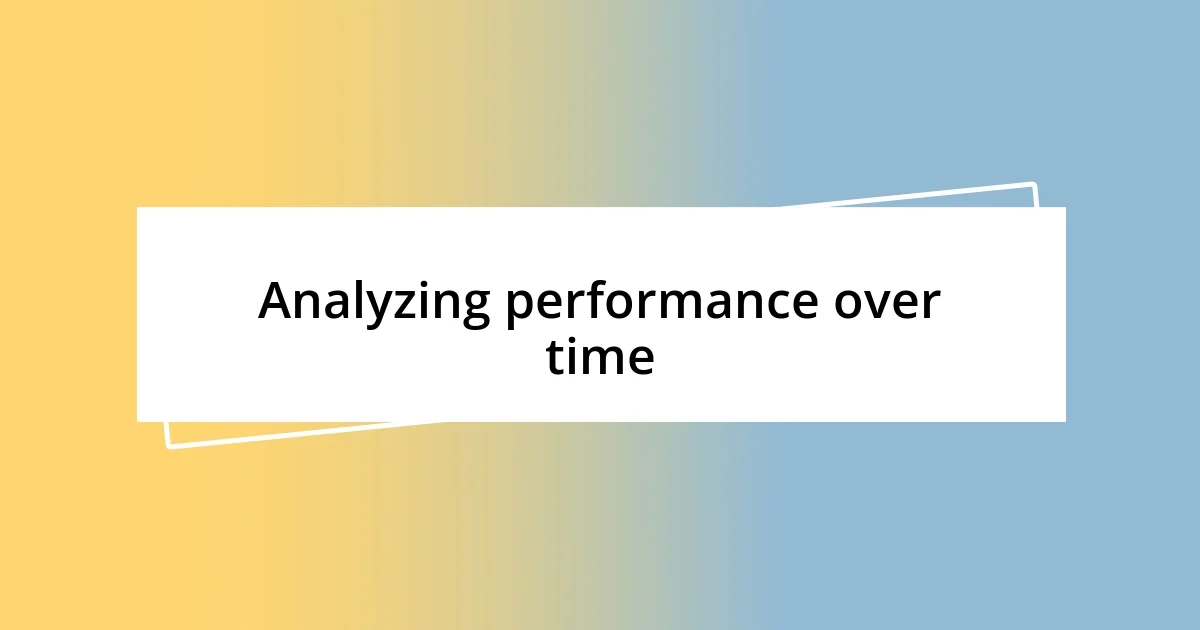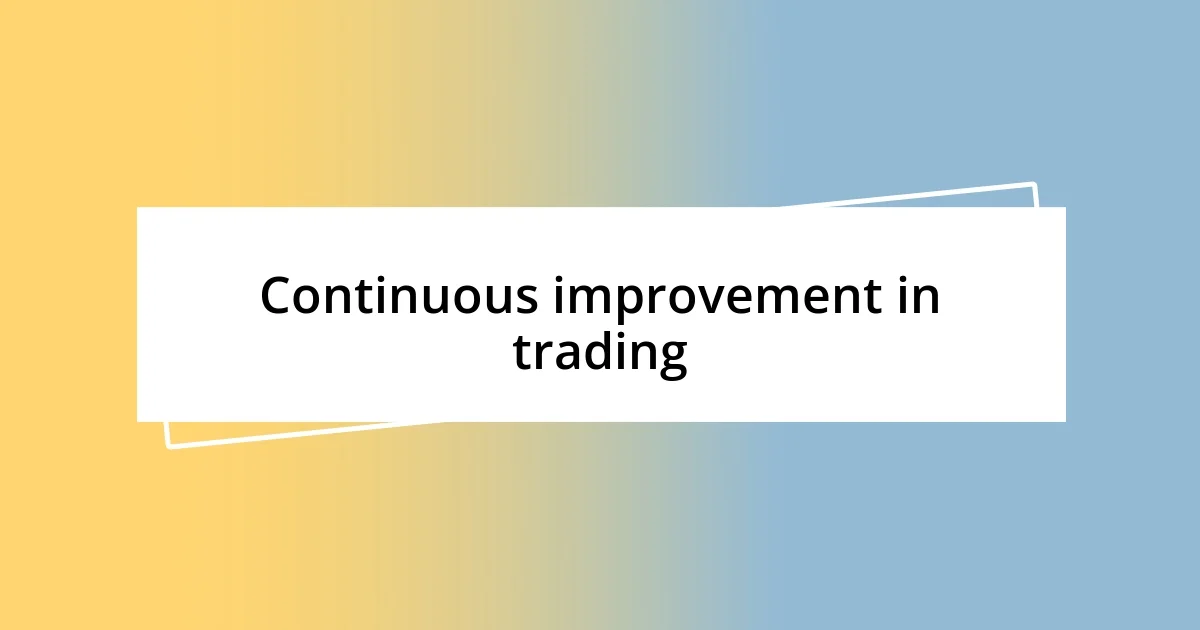Key takeaways:
- Implementing a tracking system transforms trading by revealing behavioral patterns and fostering discipline, empowering traders to make informed decisions.
- Key performance metrics like win rate, profit factor, and risk-reward ratio are crucial for refining strategies and enhancing trading performance.
- Continuous reflection and adjustment based on data and emotional responses lead to ongoing improvement in trading strategies and overall skills.

Introduction to tracking performance
Tracking performance in trading is essential, and I can’t emphasize that enough based on my own experiences. Early in my trading journey, I would often let my emotions dictate my decisions, leading to impulsive trades that didn’t pan out. Reflecting on those moments now, I realize that having a structured way to monitor my performance could’ve provided the clarity I desperately needed.
When I finally implemented a tracking system, I discovered patterns in my behavior that I hadn’t noticed before. Have you ever found yourself repeating the same mistakes, only to wonder why? I know I have. By analyzing data, such as win rates and average returns, I felt empowered and more in control of my trading strategy.
The act of tracking not only changes how we perceive our successes and failures but also helps foster a sense of discipline. I remember feeling a mix of excitement and anxiety the first time I compared my results month by month. It was transformative to see my progress laid out clearly, and it reinforced the importance of consistency in trading.

Understanding key performance metrics
Understanding key performance metrics is crucial in refining my trading strategy. Over the years, I realized that two of the most significant metrics for me were the win rate and profit factor. My win rate, which measures the percentage of winning trades, often served as a confidence boost. Yet, it wasn’t until I learned about the profit factor—essentially the ratio of gross profits to gross losses—that I began to appreciate the bigger picture. This metric highlighted the quality of my trades, not just the quantity, helping me reevaluate the types of trades I was making.
I’ve also found average trade duration to be an interesting metric to analyze. Initially, I would jump in without a solid plan, leading to a mix of short-lived gains and unexpected losses. I recall a particular scenario where I held onto a losing trade out of sheer stubbornness, thinking it would turn around. When I eventually looked at my average trade duration, it revealed a pattern that I hadn’t wanted to face. Recognizing that I was often holding trades far longer than necessary guided me toward more strategic exit points.
Another invaluable metric is risk-reward ratio, which helps me evaluate whether the potential reward justifies the risk I’m taking. I remember setting a goal to maintain a minimum ratio of 2:1. By tracking this, I gained insight into my trade management and decision-making process. It kept me mindful of the risk involved, instilling a sense of responsibility that sometimes my emotions dulled. Overall, understanding these key metrics has equipped me with a valuable toolkit to enhance my trading performance.
| Metric | Description |
|---|---|
| Win Rate | Percentage of winning trades |
| Profit Factor | Ratio of gross profits to gross losses |
| Average Trade Duration | Average time trades are held |
| Risk-Reward Ratio | Comparison of potential profit to potential loss |

Tools for monitoring trades
Using the right tools for monitoring trades can make all the difference in improving your trading performance. Over time, I’ve experimented with various tools, both software and simple spreadsheets, to track my trades and gather essential performance data. I remember the frustration of feeling lost after a series of bad trades; it was the moment I decided to adopt a dedicated trading journal that everything started to change for the better. It allowed me to see not just the numbers, but the emotional state I was in during each trade, which was an eye-opener.
Here are some tools I’ve found particularly useful for monitoring trades:
- Trading Journals: A practical way to record trades, emotions, and outcomes. I can reflect on what worked and what didn’t.
- Spreadsheets: Customizable to track metrics like win rates and profit factors. This allowed me to visualize my data more effectively.
- Specialized Trading Software: Platforms like MetaTrader or TradingView offer built-in analytics that can really bring performance metrics to life.
- Mobile Apps: Apps like My Trade Journal make it easy to input trades on the go, ensuring I capture insights in real-time rather than relying on memory later.
- Backtesting Tools: I found historical simulation tools invaluable to test trading strategies and see how they would have performed in different market conditions.
In my experience, integrating these tools has not only streamlined my tracking process but has also deepened my understanding of my trading behavior. Just like a sports coach analyzing game footage, reviewing my trades clarified my strengths and weaknesses, pushing me to improve constantly.

Creating a trading journal
Creating a trading journal has been a game-changer for me in understanding my trades on a deeper level. I remember the first time I jotted down my thoughts after a particularly stressful trading session. It was eye-opening to see the correlation between my emotions and trading outcomes. Was I overly confident after a win? Did fear paralyze me during a loss? Writing it all down provided clarity I never had before.
I’ve learned that simply recording trades isn’t enough; reflecting on each one is vital. Some days, I’d write pages about a single trade, detailing my thought process and the market conditions at the time. Looking back, I can see patterns emerge that guide my future strategies. It’s fascinating how the act of reflection not only captures the technical aspects but also the psychological layers of trading.
Moreover, I’ve started to categorize my entries by themes, like ’emotional pitfalls’ or ‘successful risk management.’ This allows me to track recurring challenges over time. Have you ever read something from months ago and felt like it was a message from your past self? That’s what my journal has done for me—it’s an evolving guide that constantly reminds me to stay grounded and focused in this often unpredictable environment.

Analyzing performance over time
Analyzing performance over time has been key to my growth as a trader. I still remember that moment when I looked back at three months’ worth of trades and realized how much I had improved—not just in profit, but in my ability to assess risk. It was like discovering a hidden layer of my trading mindset. By tracking metrics such as my average winning and losing trades, I gained invaluable insights that I could use to refine my strategies. Have you ever felt those “aha” moments? They’re powerful!
Each month, I review my trading performance and look for trends. I examine the times I was most successful and the periods that hurt my portfolio. For example, there was a month when I noticed my win rate dropped significantly during high-volatility events. What was I thinking? Seeing that pattern helped me create stricter guidelines for my trades during such times. It’s amazing how time can reveal those blind spots, right?
Furthermore, I often reflect on my emotional responses during various trading phases. In one instance, after a lucrative series of wins, I felt invincible, which led to overconfidence in my next trades. This experience taught me the importance of humility in trading. After analyzing that phase, I now set reminders for myself to calibrate my mindset after wins and losses, ensuring I stay grounded. When was the last time you took a step back to truly evaluate your trading journey? It can be eye-opening!

Adjusting strategies based on data
When it comes to fine-tuning my trading strategies, I’ve learned that data is my best friend. I recall a period when I encountered a string of losses that seemed unending. Analyzing my trades revealed that I was frequently jumping into positions with inadequate setups. By adjusting my criteria based on this feedback, I managed to turn those statistics around. Have you ever found yourself overlooking simple details? It’s those nuances that can truly make or break your performance.
There was also a time when I relied heavily on one specific indicator for my trades. I felt confident in its ability to deliver signals based on past successes. However, as I dug into the data, it became clear that it wasn’t providing the same edge in a changing market environment. Adapting my strategy to incorporate multiple indicators allowed me to diversify my approach, which not only improved my success rate but also eased the emotional toll of trading. Isn’t it interesting how the more we learn, the more we realize we need to pivot?
Looking at my data over time, I’ve discovered that certain strategies perform better in specific market conditions. For instance, I remember a series of trades I executed during a bullish trend that seemed effortless. However, as the market shifted, those same strategies faltered. Adjusting my strategies based on macroeconomic indicators helped me navigate through those transitions more smoothly. Can you relate? It’s essential to stay flexible and responsive; otherwise, you risk getting left behind.

Continuous improvement in trading
The journey of continuous improvement in trading is a dynamic process that I cherish deeply. Reflecting on my past, I recall a period where setbacks felt overwhelming. Yet, instead of succumbing to frustration, I chose to dissect each trade. Each loss had a lesson wrapped in it, which opened my eyes to aspects of my strategy that required adjustment. Don’t you think that every setback carries a hidden opportunity for growth?
In some cases, I’ve found that revisiting old trades—sometimes even months later—can reveal insights I missed at first glance. I remember a time I looked back at a particular series of trades that had initially seemed so straightforward. Analyzing them later, I noticed patterns that I had overlooked, especially regarding my emotional states during those trades. It made me realize how important it is to keep a reflective mindset. Have you ever unearthed insights in your past decisions that shifted your current approach?
Moreover, I often compare my evolution as a trader to nurturing a plant. Just as it requires regular attention and adaption to its environment, my trading strategies demand the same care. I encountered fluctuations where my tried-and-true methods weren’t yielding results. Instead of feeling defeated, I sought to adapt, finding new techniques and strategies to fuel my journey. Isn’t it invigorating to know that with each experience, we plant the seeds for future success?














